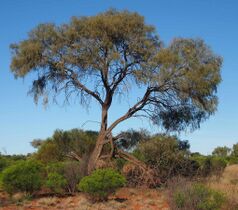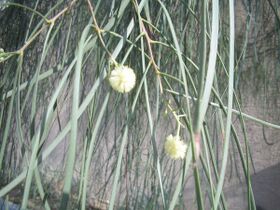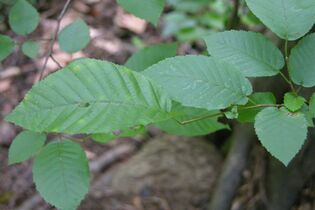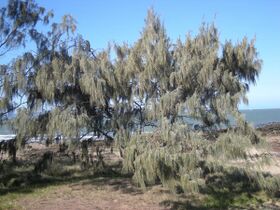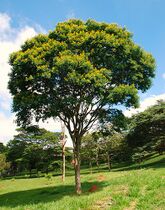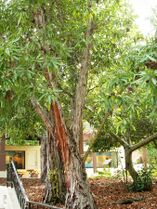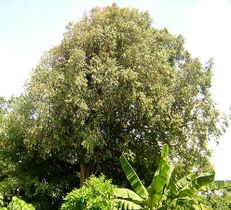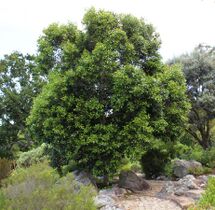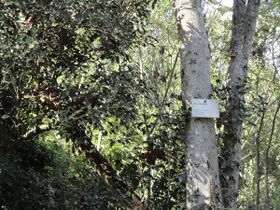Biology:Ironwood
From HandWiki
Ironwood is a common name for many woods or plants that have a reputation for hardness, or specifically a wood density that is heavier than water (approximately 1000 kg/m3, or 62 pounds per cubic foot), although usage of the name ironwood in English may or may not indicate a tree that yields such heavy wood.
Some of the species with their common name
- Acacia aulacocarpa (Brush ironwood)
- Acacia estrophiolata (Southern ironwood), central Australia[1]
- Acacia excelsa (Ironwood)
- Acacia melanoxylon (Ironwood)
- Acacia stenophylla (Ironwood), Australia
- Aegiphila martinicensis (Ironwood)
- Afzelia africana (Ironwood)
- Androstachys johnsonii (Lebombo ironwood), southeastern Africa and Madagascar [2]
- Allagoptera caudescens, Borassus flabellifer, Caryota urens, Iriartea deltoidea Black Palm, Palmira wood (Black ironwood)
- Argania spinosa (Morocco ironwood, Thorny, Prickly ironwood)
- Astronium fraxinifolium, Astronium urundeuva (Ironwood)
- Backhousia bancroftii (Bancroft's ironwood)
- Backhousia citriodora (Lemon ironwood), northeastern Australia
- Backhousia myrtifolia (Carrol ironwood, Ironwood)
- (Backhousia subargentea Syn.: Choricarpia subargentea) (Giant ironwood), eastern Australia[3]
- Bridelia micrantha (Benin or Yoruba ironwood), Bridelia atroviridis (Yoruba ironwood)
- Carpinus caroliniana American hornbeam (Ironwood, Blue-beech ironwood, Smooth-barked ironwood), eastern North America[4]
- Casuarinaceae, She-oaks in general, Southeast Asia (Australian ironwood)
- Allocasuarina spp.; Allocasuarina luehmannii, Allocasuarina torulosa, Allocasuarina inophloia (Ironwood), Allocasuarina verticillata (Long-leaved, Longleaf ironwood, Highland or Mountain ironwood)
- Casuarina cunninghamiana (Small-cone ironwood, Australian coast ironwood, River-oak ironwood)
- Casuarina equisetifolia Toa (Beach, Coast ironwood, Pacific, Sea, South Sea or Polynesian ironwood or Short-leaf and False ironwood, Lowland Ironwood), native from Burma south to Australia[5]
- Casuarina cristata (Ironwood)
- Casuarina glauca (Long-leaf Ironwood, Saltmarsh Ironwood, Blue ironwood)
- Casuarina stricta (Highland ironwood, Fodder ironwood)
- Casuarina junghuhniana (Mountain Ironwood)
- (Cenostigma pluviosum Syn.: Caesalpinia pluviosa) (Bolivian ironwood)
- Cercocarpus spp. (Ironwood), Cercocarpus betuloides (Mountain ironwood)
- Chionanthus battiscombei (Water pock ironwood, Small-fruited ironwood, Water Ornate-leaf(ved) ironwood)
- Chionanthus caymanensis (Ironwood, Cayman ironwood)
- Chioanthus compactus (White ironwood)
- Chionanthus panamensis, Chionanthus ligustrinus (Pine ridge ironwood)
- Chionanthus peglerae (Bastard black ironwood or Giant pock ironwood and Pegler's bastard ironwood, Large-leaved ironwood)
- (Citharexylum flexuosum Syn.: Citharexylum spinosum) (White ironwood)
- Cliftonia monophylla (Ironwood)
- Coccoloba pubescens (Broad-leaved ironwood)
- Colophospermum mopane (Black ironwood, Rhodesian ironwood)
- Colubrina elliptica (Ironwood, Martinique ironwood), Colubrina arborescens (West Indian ironwood)
- Combretum imberbe (Ironwood)
- Cordia subcordata (Ironwood)
- Cossinia pinnata (Judas ironwood)
- Cryptocarya lauriflora (Borneo ironwood), Cryptocarya ferrea (Java ironwood)
- Cynometra alexandri (Uganda ironwood), central and east Africa[6]
- Cyrilla racemiflora (Ironwood, Swamp ironwood)
- Dalbergia melanoxylon (African ironwood)
- Dialium guianense (Ironwood)
- Diploglottis australis Syn.: Diploglottis cunninghamii) (Australian, New Holland ironwood)
- Distylium racemosum (Japanese ironwood)
- Drypetes gerrardii (Bastard white ironwood, Forest ironwood)
- Erythrophleum chlorostachys Steelwood (Cooktown ironwood, Red or Northern ironwood, Leguminous ironwood, Poisonous ironwood), native to northern Australia[7]
- Erythroxylum areolatum (Cartagena ironwood, Jamaica ironwood)
- Eucalyptus spp. (Australian ironwood)
- Eugenia confusa (Red berry ironwood, Tropical ironwood)
- Eusideroxylon zwageri (Borneo ironwood, Chinese ironwood, Real or True ironwood), southeast Asia
- Exostema caribaeum (Bastard ironwood)
- Exothea paniculata (Ironwood)
- Fagraea fragrans (Sumatra or Java ironwood)
- Fagara lentiscifolia (Bastard ironwood)
- Forestiera pubescens (Ironwood)
- Forestiera pubescens var. parvifolia (New Mexican ironwood)
- Genipa americana (Brazilian ironwood)
- Gordonia haematoxylon (Ironwood)
- Gossia bidwillii (Smooth-barked ironwood, Scrub ironwood), Gossia acmenoides (Scrub ironwood), Gossia dulcis (Ironwood), Gossia floribunda (Cape ironwood), Gossia myrsinocarpa (Malanada ironwood)
- Gymnanthes lucida (Narrow-leaf ironwood)
- (Gymnostoma nodiflorum Syn.: Casuarina nodiflora ) (Knot-flowered ironwood)
- (Gymnostoma papuanum Syn.: Casuarina papuana) (Papuan ironwood)
- (Gymnostoma sumatranum Syn.: Casuarina sumatrana) (Ironwood)
- Handroanthus spp. formerly Tabebuia spp.; Handroanthus heptaphyllus, Handroanthus serratifolius etc., Ipê, Brazilian walnut, Lapacho, Yellow poui (Ironwood)
- Heritiera trifoliolata Black stavewood, Heritiera actinophylla Stavewood (Ironwood)
- Holodiscus discolor Oceanspray (Ironwood), western North America[8]
- Homalium dentatum, Homalium letestui (Brown ironwood), Homalium rufescens (Small-leaved brown ironwood), Homalium abdessammadii (Zambezi brown ironwood)
- Hopea odorata, Hopea parviflora (Malabar, Ceylon ironwood)
- Hypelate trifoliata (White ironwood)
- Ilex mitis (Lance-leaved ironwood, Smooth or Mild, Unarmed ironwood)
- Inhambanella henriquesii (Rock, Water or Small ironwood)
- Intsia bijuga, Intsia palembanica (Moluccan, Madagascar ironwood)
- Ixora ferrea (Ironwood, West Indian ironwood, Martinique ironwood, Red ironwood, Three-flowered ironwood)
- Jacquinia keyensis (Ironwood)
- Krugiodendron ferreum (Black ironwood, Caribbean or Guadeloupe ironwood), Caribbean
- (Libidibia ferrea Syn.: 'Caesalpinia ferrea) (Brazilian ironwood), Brazil[9]
- Lignum vitae; Guaiacum officinale, Guaiacum sanctum and Argentine, Paraguay Lignum Vitae, Verawood Bulnesia arborea also als Maracaibo Lignum Vitae and Bulnesia sarmientoi (Ironwood)
- Lophira alata (West African ironwood, (Small) Red ironwood, Dwarf (red) ironwood, Dryzone (red) ironwood), western and central Africa[10]
- Lophira lanceolata ((Dwarf) Red ironwood)
- Lyonothamnus floribundus (Catalina or Western ironwood, Island or Santa Cruz (Island) Ironwood, Lyon's Ironwood or Fern-leaved ironwood), in the rose family, Channel Islands of California[11]
- Manilkara hexandra (Ceylon ironwood)
- Manilkara kauki (Moluccan ironwood)
- Mesua ferrea (Sri Lankan or Ceylon and Assam ironwood, East Indian Ironwood), southern and southeastern Asia[12]
- Metrosideros spp. all Species (Ironwood), Metrosideros umbellata (New Zealand Ironwood), Metrosideros kermadecensis (Real or True ironwood)
- Millettia grandis (Kafir ironwood)
- Minquartia guianensis (Ironwood)
- Mouriri myrtilloides (Small-leaved ironwood)
- Myoporum obscurum (Bastard ironwood)
- Myracrodruon urundeuva (Ironwood)
- Nestegis apetala (Bastard ironwood), New Zealand and Norfolk Island[13]
- Notelaea ligustrina (Tasmanian ironwood, New-South-Wales ironwood)
- Notelaea longifolia (Norfolk-Island ironwood)
- (Noronhia foveolata Syn.: Chionanthus foveolatus) (Pock ironwood, Bastard ironwood or Cape pock ironwood, Bastard, Forest pock ironwood, Ornate-leaf(ved), Fine-leaved ironwood) native to southern Africa[14]
- Ochna holstii (Red ironwood)
- Oldfieldia africana (West African ironwood)
- Olea capensis (Bastard Black, Forest, Bushveld or False, Bastard ironwood, South African ironwood, Small and Olive ironwood, East African ironwood), Africa[15]
- Olea woodiana (Black ironwood), eastern and southern Africa[16]
- Olinia ventosa (Sproutful ironwood)
- Olneya tesota (desert ironwood, Arizona or Sonora ironwood, Mexican ironwood)
- Ostrya knowltonii Knowlton's or Western hophornbeam (Canyon ironwood, Western Ironwood)
- Ostrya virginiana Hophornbeam, (North-American, American ironwood, Canadian ironwood, Rough-barked ironwood, Eastern ironwood)
- Palicourea cardiomorpha subsp. cardiomorpha (Panicled-flowered ironwood)
- Parrotia persica (Persian ironwood, Transcaucasian ironwood)
- Parrotia subaequalis (Chinese ironwood)
- Paubrasilia echinata (Ironwood)
- Peltophorum rufum (Cochinchina ironwood)
- Pemphis acidula (Maldivian ironwood)
- Picrodendron baccatum (Black ironwood)
- Planchonella costata (Bastard ironwood)
- Planchonella obovata (Silvery ironwood, Obovate ironwood)
- Prosopis juliflora, Prosopis glandulosa (Texas ironwood), Prosopis kuntzei, Prosopis africana (Ironwood) Mesquite
- Prunus africana (Ironwood)
- Quebracho Schinopsis spp.; Schinopsis brasiliensis, Schinopsis balansae, Schinopsis lorentzii and Aspidosperma quebracho-blanco (Ironwood)
- Rapanea melanophloeos (Laurel-leaved ironwood)
- Rauvolfia sandwicensis (Hawaiian ironwood)
- Reynosia septentrionalis, Reynosa latifolia (Red ironwood)
- Rhodamnia acuminata (Cooloola ironwood)
- Rhodomyrtus trineura var. canescens (Crater ironwood), Rhodomyrtus pervagata (Rusty ironwood)
- Rothmannia capensis (Black ironwood, Cape of Good Hope ironwood)
- Schleichera oleosa (Ironwood)
- Senegalia intsia (Indian ironwood)
- Senegalia muricata (Ironwood)
- Senegalia tenuifolia (Antillean ironwood)
- Senna siamea (Indonesian or Indian ironwood)
- Sideroxylon spp. (Ironwood);
- Sideroxylon inerme (Smooth or White ironwood, Broad-leaved, Unarmed ironwood, Cape or East African ironwood)
- Sideroxylon lanuginosum or Gum bully (Ironwood)
- Sideroxylon lycioides (American ironwood, Canada thorny ironwood, Willow-leaved, Boxthorn-leaved ironwood, Ten-threaded, Decandrous ironwood, Bumelia ironwood)
- Sideroxylon tenax (Silky(-leaved) ironwood, Silvery-leaved ironwood)
- Sideroxylon celastrinum (Ironwood)
- Sideroxylon cinereum (White ironwood, Bourbon or Mauritius ironwood)
- Sideroxylon foetidissimum (Opposite-leaved ironwood)
- Sideroxylon lanuginosum (Woolly-leaved ironwood)
- Sideroxylon reclinatum (Reclined ironwood)
- Sloanea dentata (Black ironwood, Broad-leaf ironwood)
- Sloanea jamaicensis, Sloanea sinemariensis (Ironwood)
- Stadmania spp. (Ironwood, Bois de fer, Mauritius ironwood), Stadmania oppositifolia (Bourbon ironwood)
- Swartzia spp.; Swartzia tomentosa (Cayenne ironwood), Swartzia bannia, Swartzia bidentata, Swartzia leiocalycina, Swartzia ingifolia, Swartzia grandifolia, Swartzia panacoco (Guiana ironwood) etc. (Ironwood, South American ironwood, Suriname ironwood)
- Terminalia canescens (Ironwood)
- Tetragastris balsamifera (West Indian ironwood)
- Thouinia striata (Ironwood, Quebracho)
- Trichilia hirta (Bastard ironwood)
- Tristaniopsis laurina (Canungra ironwood)
- Vachellia farnesiana (Ironwood)
- Vepris lanceolata (White ironwood), Vepris reflexa (Woodland white ironwood, Bushveld white ironwood, Drooping or Rock white ironwood), Vepris undulata (White ironwood), Vepris carringtoniana (Coastal white ironwood, Wing-leaved white ironwood), Vepris zambesiaca (Rare white ironwood), Vepris termitaria (Riverine white ironwood) native to South Africa
- Vernonia angustifolia (Narrow-leaf ironwood)
- Vernonia gigantea (Oval-leaved ironwood)
- Xanthostemon species collectively known as "Philippine ironwood", all endemic to the Philippines[17]
- Xanthostemon bracteatus (Mapilig)
- Xanthostemon fruticosus (Sierra Madre mangkono)
- Xanthostemon philippinensis (Bagoadlau)
- Xanthostemon verdugonianus (Mangkono)
- Xanthostemon speciosus (Palawan mangkono)
- Xanthostemon verus (Asian or Moluccan, Real or True ironwood)
- Xantolis tomentosa (Armed ironwood, Felty, Woolly, Downy-leaved ironwood)
- Xylia xylocarpa (Burma ironwood or Myanmar ironwood)
- Zanthoxylum fagara (Bastard, False ironwood, Yellow ironwood, Jamaica, Brazilian ironwood, Intended-leaved American ironwood)
- Zanthoxylum piperitum (Crenated-leaved ironwood)
- Zanthoxylum tragodes (Prickly-leaved American ironwood)
- Zapoteca tetragona (Antillean ironwood)
Plants named ironwood
Acacia stenophylla flowers
Carpinus caroliniana leaves
Casuarina equisetifolia subsp. incana
Chionanthus foveolatus leaves
Eusideroxylon zwageri leaves
Holodiscus discolor flowers
See also
- Ironwood Island (Wisconsin)
- Ironwood, Michigan
- Ironwood State Prison
- Black ironwood (disambiguation)
- Ironbark, various Eucalyptus spp.
- Iron tree (disambiguation)
- Sideroxylon, from sideros (σιδηρος) meaning "iron", and xylon (ξύλον) meaning "wood"
- Járnviðr
References
- ↑ "Acacia estrophiolata F. Muell.". FAO. July 9, 2008. http://www.fao.org./ag/agp/agpc/doc/Gbase/new_grasses/acaest.htm.
- ↑ Yashe, Asavela; Hankey, Andrew (June 2020). "Androstachys johnsonii Prain". SANBI. http://pza.sanbi.org/androstachys-johnsonii.
- ↑ "Giant Ironwood - profile". Threatened species. New South Wales Office of Environment & Heritage. 2014-08-05. http://www.environment.nsw.gov.au/threatenedSpeciesApp/profile.aspx?id=10166.
- ↑ Metzger, F. T. (1990), Hardwoods, 2, Washington, D.C.: United States Forest Service (USFS), United States Department of Agriculture (USDA), https://srs.fs.usda.gov/pubs/misc/ag_654/volume_2/carpinus/caroliniana.htm
- ↑ Boland, D. J.; Brooker, M. I. H.; Chippendale, G. M.; McDonald, M. W. (2006). Forest trees of Australia (5th ed.). Collingwood, Vic.: CSIRO Publishing. p. 82. ISBN 0-643-06969-0. https://books.google.com/books?id=q2v3kb9tFsYC&pg=PA82.
- ↑ "Cynometra alexandri". Wood Technical Fact Sheets. USDA Forest Service. http://www.fpl.fs.fed.us/documnts/TechSheets/Chudnoff/African/htmlDocs_africa/Cynometraalexandri.html.
- ↑ Boland, D.J.; Brooker, M.I.H; Chippendale, G.M.; Hall, N. et al. (1984). Forest trees of Australia. Melbourne: CSIRO. p. 68.
- ↑ "Holodiscus discolor (Pursh) Maxim.". Plants Profile. USDA. 2008. http://plants.usda.gov/java/profile?symbol=HODI.
- ↑ {{citation | mode = cs1 | title = Caesalpinia ferrea Mart. ex Tul. | work = Germplasm Resources Information Network (GRIN) | url = https://npgsweb.ars-grin.gov/gringlobal/taxonomydetail.aspx?8289 | publisher = [[Organization:Agricultural Research ServAgricultural Research Service (ARS), United States Department of Agriculture (USDA) | access-date = }}
- ↑ "Azobe (Lophira alata)". Wildscreen Arkive. http://www.arkive.org/azobe/lophira-alata/.
- ↑ Erwin, D. M.; Schorn, H. E. (2000). "Revision of Lyonothamnus A.Gray (Rosaceae) from the Neogene of Western North America". International Journal of Plant Sciences 161 (1): 179–193. doi:10.1086/314232. PMID 10648208.
- ↑ "Mesua ferrea L. – Clusiaceae". biotik.org. http://www.biotik.org/india/species/m/mesuferr/mesuferr_en.html.
- ↑ "Nestegis apetala". New Zealand Plant Conservation Network. http://www.nzpcn.org.nz/flora_details.aspx?ID=1031.
- ↑ "Chionanthus foveolatus". Kew World Checklist of Selected Plant Families. http://apps.kew.org/wcsp/namedetail.do?name_id=367406.
- ↑ "Olea capensis". Ecocrop. FAO. http://ecocrop.fao.org/ecocrop/srv/en/cropView?id=8059.
- ↑ {{citation | mode = cs1 | title = Olea woodiana | work = Germplasm Resources Information Network (GRIN) | url = https://npgsweb.ars-grin.gov/gringlobal/taxonomydetail.aspx?434998 | publisher = [[Organization:Agricultural Research ServAgricultural Research Service (ARS), United States Department of Agriculture (USDA) | access-date = }}
- ↑ Department of the Environment and Natural Resources (DENR) (July–December 2021). "The Five Endemic Species of Philippine Ironwoods (Mangkono)". RISE 33 (2). https://erdb.denr.gov.ph/the-five-endemic-species-of-philippine-ironwoods-mangkono/.
 |
